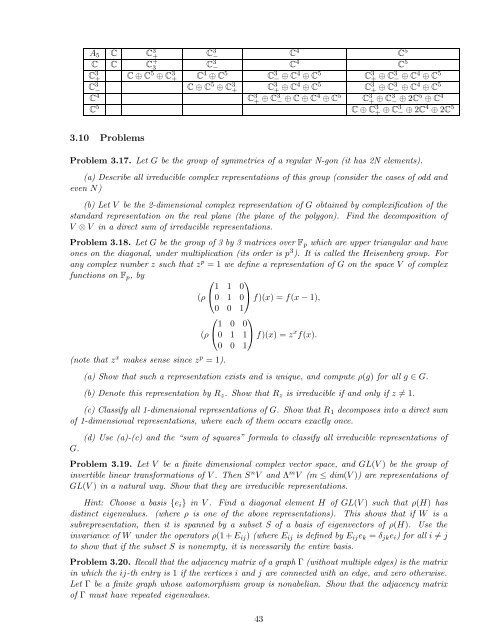Lecture notes for Introduction to Representation Theory
Lecture notes for Introduction to Representation Theory
Lecture notes for Introduction to Representation Theory
Create successful ePaper yourself
Turn your PDF publications into a flip-book with our unique Google optimized e-Paper software.
⇒<br />
C C C + 3<br />
C 3<br />
−<br />
C 3<br />
−<br />
C<br />
C− 3 4<br />
C 3 + C C 5 C<br />
3<br />
+ C 4<br />
C 5<br />
A 5 C C +<br />
3<br />
C 4 C 5<br />
C 5<br />
C C 5 C 3<br />
+<br />
C 4 C 5<br />
C 3 C 4 C 5 C 3<br />
+ C 3<br />
+ C 4 C 5 + C 3 − C 4 C 5<br />
C 3<br />
− C 4 C 5<br />
− C C4 C 5 C+ 3 C3 − 2C 5 C 4<br />
C C 3 C3<br />
2C 4 2C 5<br />
−<br />
C 3<br />
C 3<br />
+ C3<br />
+ −<br />
3.10 Problems<br />
Problem 3.17. Let G be the group of symmetries of a regular N-gon (it has 2N elements).<br />
(a) Describe all irreducible complex representations of this group (consider the cases of odd and<br />
even N)<br />
(b) Let V be the 2-dimensional complex representation of G obtained by complexification of the<br />
standard representation on the real plane (the plane of the polygon). Find the decomposition of<br />
V V in a direct sum of irreducible representations.<br />
Problem 3.18. Let G be the group of 3 by 3 matrices over F p which are upper triangular and have<br />
ones on the diagonal, under multiplication (its order is p 3 ). It is called the Heisenberg group. For<br />
any complex number z such that z p = 1 we define a representation of G on the space V of complex<br />
functions on F p , by<br />
⎧ <br />
1 1 0<br />
(δ0 1 0⎝f)(x) = f(x − 1),<br />
0 0 1<br />
⎧ <br />
1 0 0<br />
(δ0 1 1⎝f)(x) = z x f(x).<br />
0 0 1<br />
(note that z x makes sense since z p = 1).<br />
(a) Show that such a representation exists and is unique, and compute δ(g) <strong>for</strong> all g G.<br />
(b) Denote this representation by R z . Show that R z is irreducible if and only if z ⇒= 1.<br />
(c) Classify all 1-dimensional representations of G. Show that R 1 decomposes in<strong>to</strong> a direct sum<br />
of 1-dimensional representations, where each of them occurs exactly once.<br />
(d) Use (a)-(c) and the “sum of squares” <strong>for</strong>mula <strong>to</strong> classify all irreducible representations of<br />
G.<br />
Problem 3.19. Let V be a finite dimensional complex vec<strong>to</strong>r space, and GL(V ) be the group of<br />
invertible linear trans<strong>for</strong>mations of V . Then S n V and Γ m V (m ∗ dim(V )) are representations of<br />
GL(V ) in a natural way. Show that they are irreducible representations.<br />
Hint: Choose a basis {e i } in V . Find a diagonal element H of GL(V ) such that δ(H) has<br />
distinct eigenvalues. (where δ is one of the above representations). This shows that if W is a<br />
subrepresentation, then it is spanned by a subset S of a basis of eigenvec<strong>to</strong>rs of δ(H). Use the<br />
invariance of W under the opera<strong>to</strong>rs δ(1 + E ij ) (where E ij is defined by E ij e k = ζ jk e i ) <strong>for</strong> all i = j<br />
<strong>to</strong> show that if the subset S is nonempty, it is necessarily the entire basis.<br />
Problem 3.20. Recall that the adjacency matrix of a graph (without multiple edges) is the matrix<br />
in which the ij-th entry is 1 if the vertices i and j are connected with an edge, and zero otherwise.<br />
Let be a finite graph whose au<strong>to</strong>morphism group is nonabelian. Show that the adjacency matrix<br />
of must have repeated eigenvalues.<br />
43

















